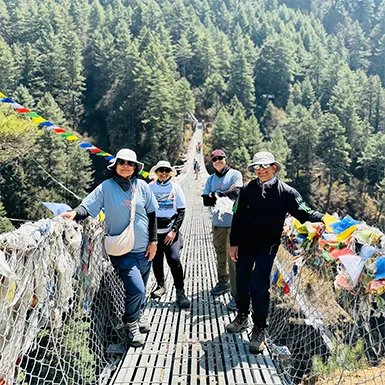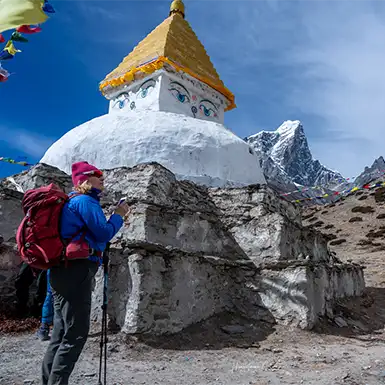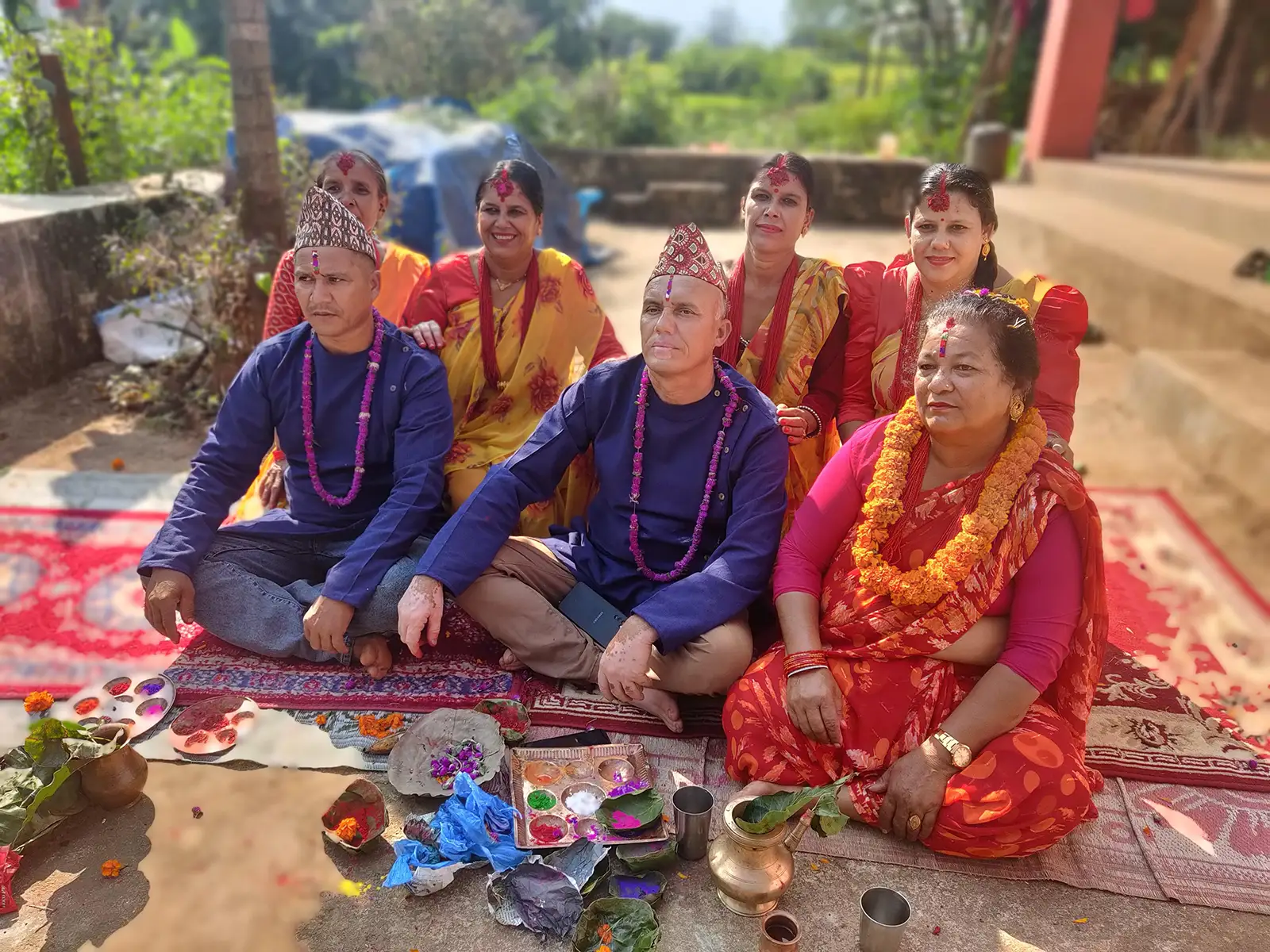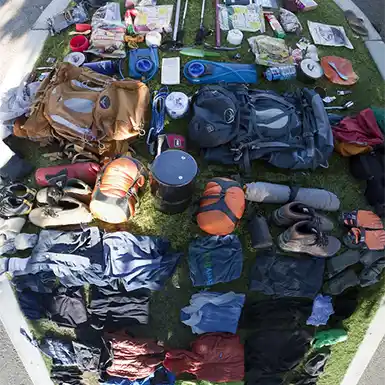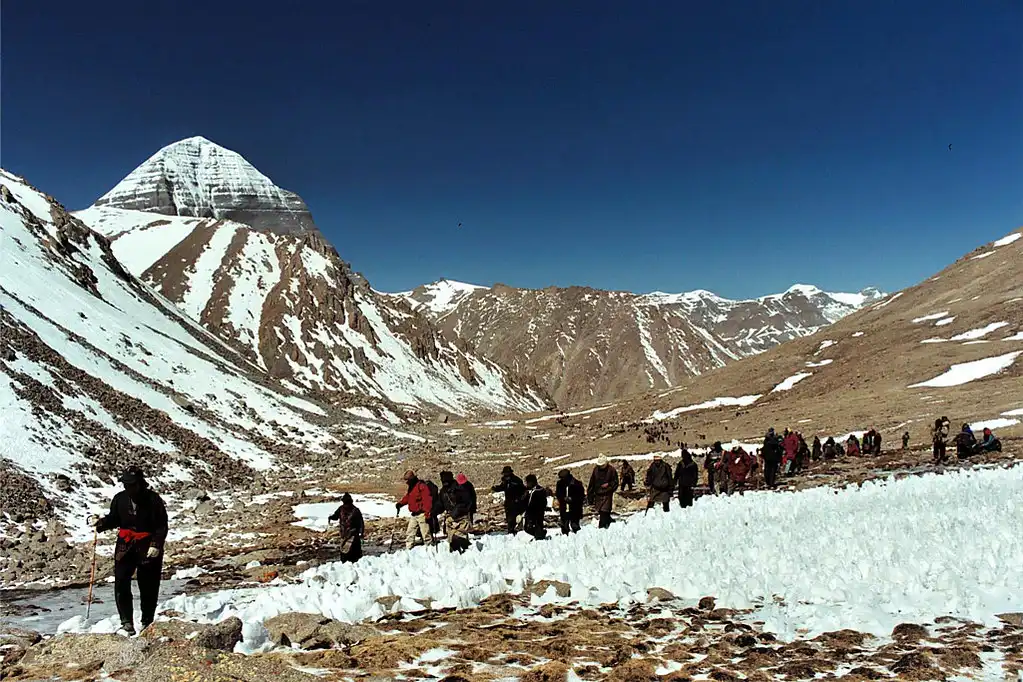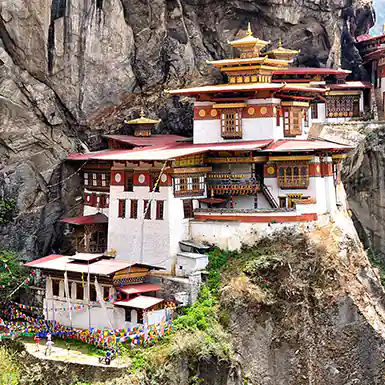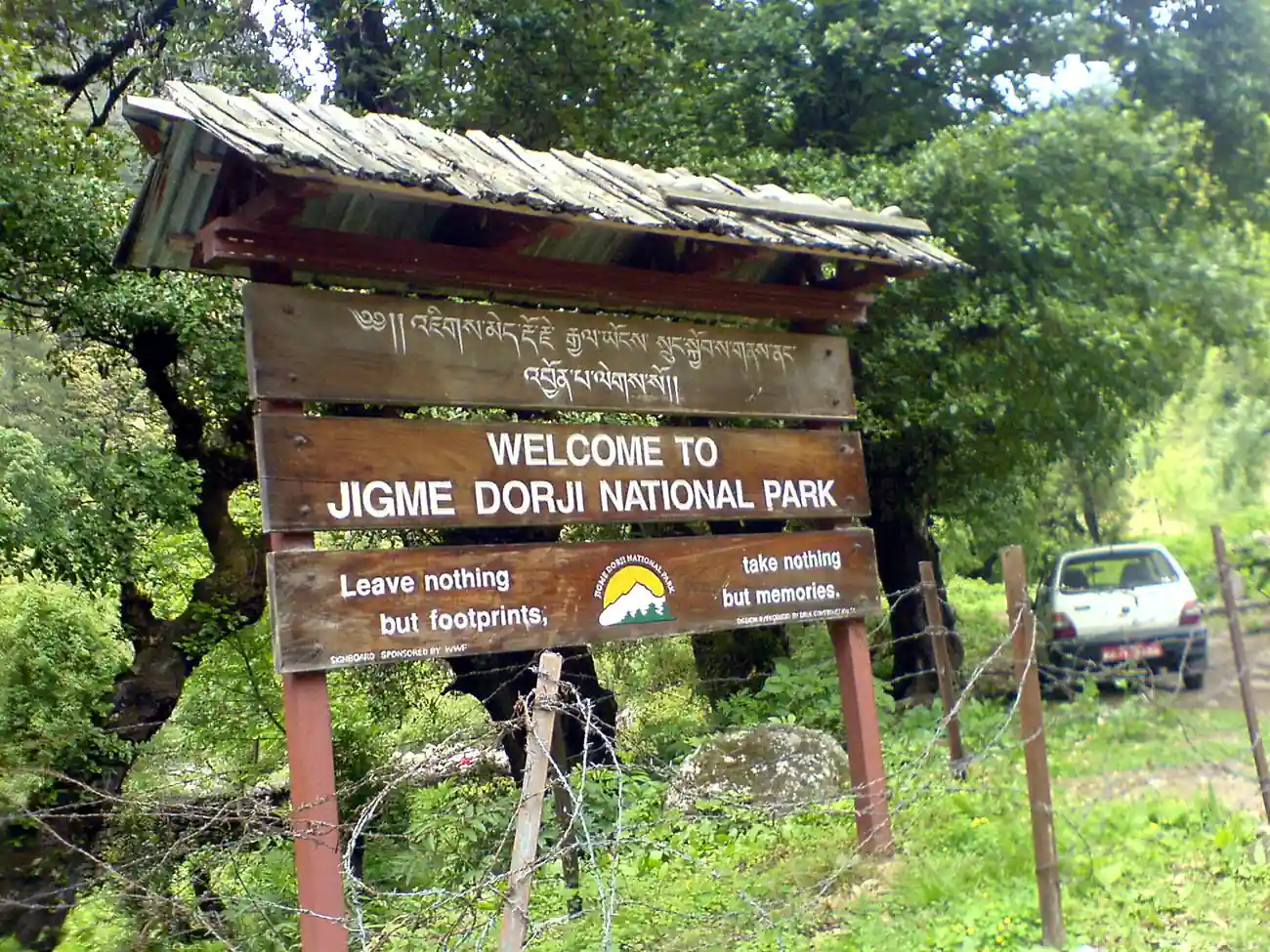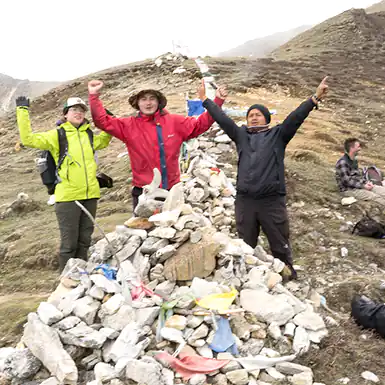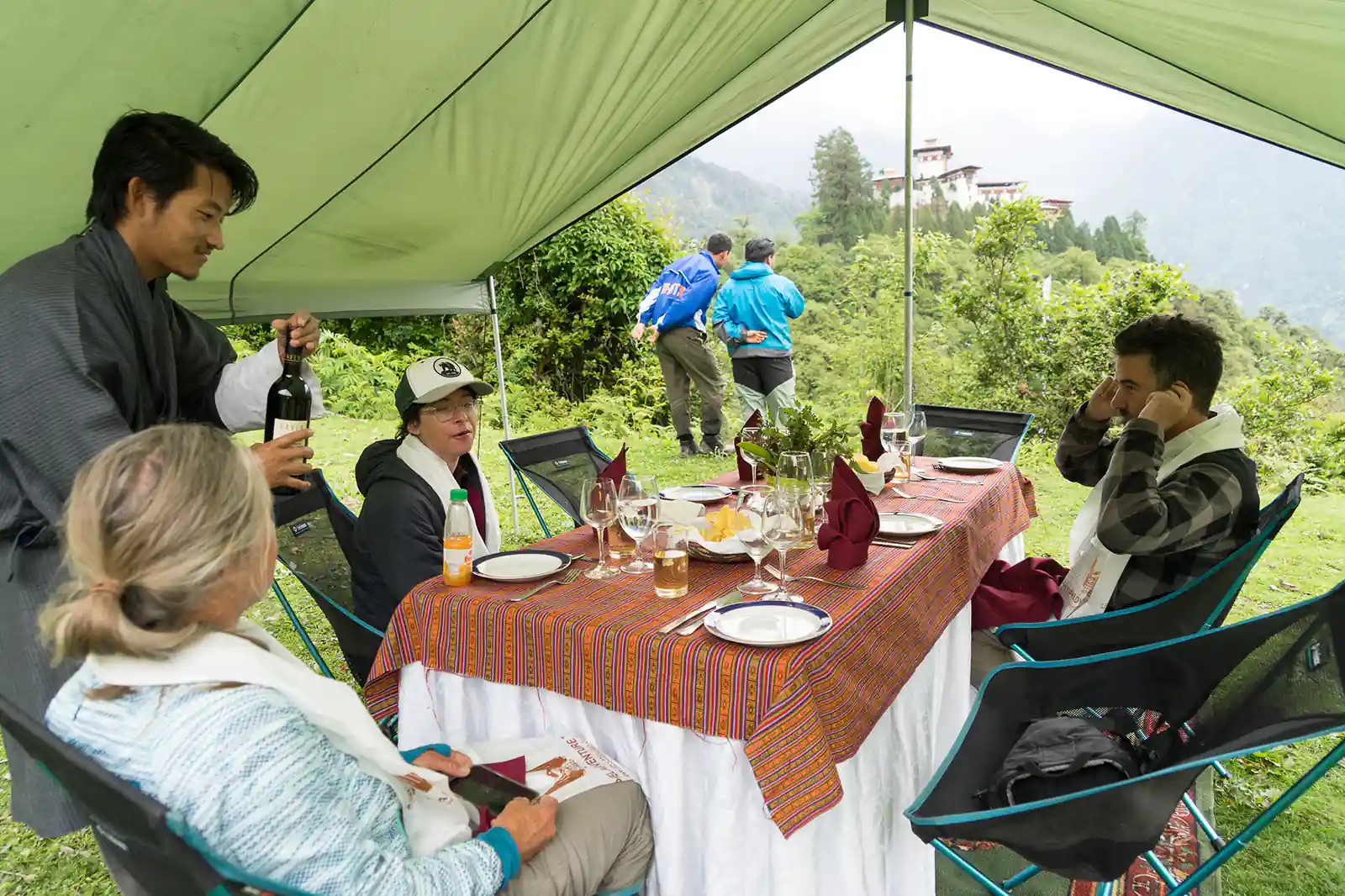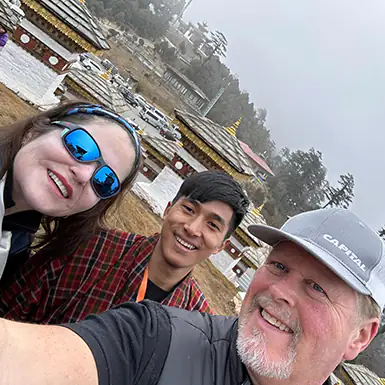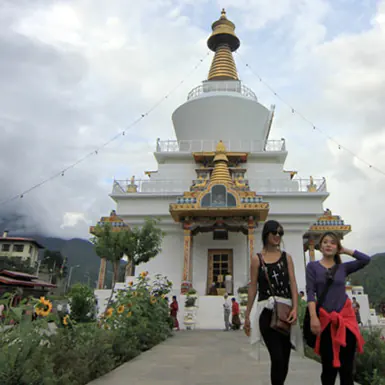Everest Base Camp in Summer: Monsoon Magic
Summer at Everest Base Camp (EBC), which spans June to August, brings the monsoon season. The monsoon alters the Mount Everest base camp weather, presenting unique challenges and rewards for adventurers in the Himalayas.
Monsoon’s Impact on Your EBC Trek
- Expect Heavy Rainfall: The monsoon delivers frequent, often intense rain, especially in the lower regions near Lukla and Namche Bazaar.
- Encounter Snow at Higher Altitudes: As moist air rises, it cools and falls as snow on the higher trails near Dingboche and Lobuche, making them slippery and difficult to navigate.
- Prepare for Reduced Visibility: Clouds and fog often obscure the iconic mountain views that EBC is famous for. Occasional breaks offer glimpses but anticipate limited visibility overall.
- Watch Out for Landslides and Trail Damage: The downpours can trigger landslides and erode trails, making trekking more complicated and potentially hazardous.
Trekking Through the Monsoon: What to Expect
- Muddy and Slippery Trails: The lower parts of the trail often become wet and muddy. Pack waterproof boots and gaiters to keep your feet dry and comfortable.
- Challenging River Crossings: Higher water levels in rivers and streams require extra caution. Utilize bridges or designated crossing points whenever possible.
- Limited Teahouse Options: Some teahouses may close during the monsoon due to fewer trekkers. Plan your accommodations carefully to ensure availability.
Is a Monsoon Trek Worth It?
The monsoon season, while challenging, has its unique charm.
- Lush and Green Scenery: The rain paints the landscape a vibrant green, with wildflowers in full bloom.
- A Quieter Trek: If you enjoy solitude, you’ll find far fewer trekkers on the trail during the monsoon.
- Immerse in Sherpa Culture: The monsoon is a time for festivities in many Sherpa villages. You might experience traditional dances, rituals, and other cultural events.
Essential Tips for Monsoon Trekking
- Gear Up for the Rain: Use a reliable rain jacket, pants, a backpack cover, and waterproof hiking boots.
- Choose Proper Footwear: Select boots with excellent traction to tackle slippery trails.
- Stay Flexible: Maintain a flexible itinerary in case the weather requires adjustments.
- Check Trail Conditions: Always stay informed about trail closures and hazards before starting.
Autumn at Everest Base Camp: A Trekker’s Delight
Autumn, spanning September to November, is the ideal time to witness the enchantment of Everest Base Camp. After the monsoon rains depart, they leave crystal-clear skies, crisp air, and comfortable temperatures, perfect for your EBC adventure.
Why Trekkers Choose Autumn
- Feast Your Eyes on the Views: Autumn’s standout feature is its clear skies. With minimal cloud cover, you’ll enjoy sweeping vistas of towering peaks, including Mount Everest. The sharp, clean air enhances visibility, creating a photographer’s dream.
- Enjoy Predictable, Pleasant Weather: Autumn delivers some of the most stable weather at EBC. Expect sunny, dry days with little chance of rain or snow, making your trek easier to plan and more enjoyable.
- Hike in Comfort: While mornings and evenings are cool, daytime temperatures in autumn are perfect for hiking. Daytime temperatures in September and October hover between 10°C and 15°C (50-59°F), gradually dipping as November begins. Prepare for chilly nights as temperatures can plummet to -5°C (23°F) or lower. Pack ample warm clothing.
- Experience Fall’s Colorful Palette: The lower valleys explode with vibrant autumn hues as the foliage changes, adding a special touch to the already breathtaking Himalayan landscape.
Trekking Conditions in the Fall
- Navigate Clean, Well-Defined Trails: After the monsoon washes away the dust, the trails remain clean and easy to follow, making your trek smoother and safer.
- Enjoy a Less Crowded Trek (At First): While autumn is a popular trekking season, it’s typically less crowded than the spring peak, especially in September. Keep in mind that more trekkers arrive as November approaches.
Things to Consider for Your Autumn Trek
- Dress in Layers: Temperatures fluctuate significantly between day and night. Bring versatile clothing layers to adjust to fluctuating weather effortlessly.
- Plan for Shorter Days: Daylight decreases as autumn progresses. Adjust your daily distances and aim to reach your teahouse well before dark.
- Prepare for Possible Snow: Late October or November can bring the season’s first snowfall, particularly at higher altitudes. Pack warm clothing and waterproof gear to stay dry and comfortable.
Winter at Everest Base Camp: A Trekker’s Icy Challenge
Winter transforms Everest Base Camp into a majestic realm of snow and ice from December to February. The weather intensifies, presenting unique challenges and exhilarating opportunities for adventurous trekkers who dare to embrace the cold.
Embrace Winter’s Grip: What to Expect
- Frigid Temperatures: Expect bitter cold, with daytime temperatures typically ranging from -10°C to -15°C (14°F to 5°F) and plummeting further at night. Wind chill can intensify the cold.
- Abundant Snowfall: Snowstorms frequently blur the landscape in snow, potentially obscuring trails. Get ready for deep snow and challenging trekking conditions.
- Shorter Days: Daylight hours are limited in winter, leaving less time for each day’s trek. Plan your itinerary carefully to reach your teahouse before nightfall.
- Frozen Water Sources: Rivers and streams freeze over, making it essential to carry extra water or a reliable method for melting snow.
A Winter Trek Unlike Any Other
- Peaceful Trails and Solitude: The harsh conditions deter most trekkers, creating a tranquil and solitary experience for those who venture out in winter. Autumn is the ideal time to visit if you seek adventure and tranquility on the trail.
- Stunning Frozen Scenery: The snow-draped landscape offers a unique and breathtaking beauty. Frozen waterfalls, icy paths, and panoramic views of snow-capped peaks create an unforgettable experience.
- Extra Challenges, Extra Rewards: Winter trekking demands higher physical and mental strength. The cold, snow, and potential for strong winds require meticulous preparation and caution.
Is Winter Trekking Your Calling?
Winter treks to EBC are only for some. They are best suited for experienced trekkers with excellent physical fitness, appropriate cold-weather gear, and prior mountaineering experience.
Essential Tips for Winter Treks
- Gear Up: Invest in top-quality insulated clothing, a 4-season sleeping bag, and mountaineering boots for snow and ice.
- Experience Matters: Trekkers should have prior winter trekking or mountaineering experience. You’ll need knowledge of navigation, avalanche safety, and emergency procedures.
- Acclimatize Slowly: Gradual acclimatization is even more crucial in winter to avoid altitude sickness and other cold-related conditions.
- Seek Local Guidance: Choose a local guide with experience in winter trekking. Their knowledge of trails and weather conditions is invaluable for a safe adventure.
Everest Base Camp Weather by Month: Your Ultimate Guide
To plan the perfect Everest Base Camp trek, you must understand the Mount Everest Base Camp weather throughout the year. This detailed monthly breakdown reveals the average Everest base camp temperature, precipitation, and typical weather patterns you can expect each month.
January
- Temperatures: Daytime highs will be around -6°C (21°F), plunging to -17°C (1°F) at night.
- What to Expect: It’s cold and dry, but the clear skies offer excellent visibility.
- Key Considerations: Pack for extreme cold and ensure proper acclimatization to the altitude.
February
- Temperatures: Things warm up slightly, with daytime highs around -2°C (28°F) and nighttime lows around -15°C (5°F).
- What to Expect: Like in January, skies remain clear, and conditions are dry.
- Key Considerations: While still very cold, this month is more comfortable than January.
March
- Temperatures: Daytime highs climb to around five °C (41°F), but nights remain frosty with an average of -8°C (17°F).
- What to Expect: Days become sunnier and longer, with less chance of snow.
- Key Considerations: It’s an excellent time to trek, but pack warm clothes for the evenings and higher elevations.
April
- Temperatures: Enjoy pleasant daytime highs of around ten °C (50°F) and nighttime lows of about -5°C (23°F).
- What to Expect: Clear skies, stable weather, and milder temperatures make April a popular trekking month.
- Key Considerations: Trails get busier as the season progresses.
May
- Temperatures: Before the monsoon arrives, May boasts the warmest temperatures, with daytime highs around 15°C (59°F) and lows hovering around freezing.
- What to Expect: Sunny days prevail, but occasional afternoon showers are possible.
- Key Considerations: May is another fantastic month for trekking with comfortable temperatures, but be prepared for potentially larger crowds on the trails.
June
- Temperatures: Daytime temperatures range from 17°C (62°F) to an excellent five °C (41°F) at night.
- What to Expect: The monsoon season starts, increasing humidity and the chance of rain and high-elevation snow.
- Key Considerations: Trekking becomes more challenging as the weather shifts.
July & August
- Temperatures: Daytime averages are around 16°C (60°F), while nighttime temperatures settle around six °C (42°F).
- What to Expect: The monsoon season peaks with heavy rainfall and limited visibility.
- Key Considerations: Most trekkers avoid these months due to the difficult weather conditions.
September
- Temperatures: Daytime highs dip slightly to 12°C (53°F), with nights cooling to -2°C (28°F).
- What to Expect: The monsoon gradually recedes, bringing clearer skies and less rain.
- Key Considerations: Conditions improve for trekking as the weather transitions.
October
- Temperatures: A favorite among trekkers, October offers pleasant temperatures averaging ten °C (50°F) during the day and -5°C (23°F) at night.
- What to Expect: Clear skies and stable weather provide excellent views.
- Key Considerations: Trail conditions are typically good, but you might encounter more trekkers.
November
- Temperatures: A further cooldown brings daytime highs of 5°C (41°F) and nighttime lows dipping to -10°C (14°F).
- What to Expect: The clear skies continue, but the first snow flurries may arrive later in the month.
- Key Considerations: Enjoy fewer crowds, stunning fall foliage, and crisp trekking weather.
December
- Temperatures: Winter sets in, with average daytime highs around 0°C (32°F) and nighttime lows of -15°C (5°F).
- What to Expect: The weather is cold and dry, with clear skies and possible snow.
- Key Considerations: Trekking becomes more demanding with the cold and reduced daylight.
Everest Base Camp Temperatures: Mastering the Himalayan Wardrobe
The Everest base camp temperature is a significant factor in your trekking adventure, influencing your comfort and safety throughout the journey. Understanding the dramatic temperature swings is critical to staying comfortable, safe, and prepared for any weather surprises you encounter on the trail.
Day vs. Night: A Weather Roller Coaster
- Daytime: EBC’s daytime temperatures vary greatly depending on the season, from pleasantly warm to bone-chilling cold. Spring and autumn days typically reach highs of 10-15°C (50-59°F), feeling even warmer in direct sunlight. Summer monsoon days offer milder averages of around 16°C (60°F). Winter days, however, are frigid, barely reaching 0°C (32°F).
- Nighttime: Regardless of the season, temperatures plummet after the sun sets. Expect sub-zero temperatures, especially as you gain altitude. In spring and autumn, expect nighttime temperatures to drop to -5°C to -10°C (23-14°F), while winter nights can plunge even lower, reaching -15°C (5°F) or below.
Altitude Amplifies the Chill
Temperatures drop as altitude increases. Mount Everest base camp weather is notoriously unpredictable. As you ascend, pack layers to adjust your clothing to match the changing conditions.
Packing for a Comfortable Trek
- Base Layers: Choose moisture-wicking base layers made from merino wool or synthetic fabrics to regulate your body temperature and keep you dry.
- Insulating Layers: Fleece jackets, down vests, and thermal tops provide essential warmth when the mercury drops.
- Weather Protection: A waterproof and windproof jacket is necessary to shield you from rain, snow, and cold winds.
- Versatile Pants: Convertible hiking pants allow you to adapt to varying temperatures throughout the day.
- Essential Accessories: Don’t forget hats, gloves, and neck gaiters to warm your extremities in chilly conditions.
Pro Tip: Layering is critical to staying comfortable. Wear layered clothing to adapt to fluctuating temperatures and prevent discomfort.
Altitude’s Impact on Everest Base Camp Weather: Prepare for the Unexpected
The towering elevation of 5,364 meters (17,598 feet) at Everest Base Camp dramatically shapes its weather patterns, making Everest Base Camp weather a crucial aspect to consider when planning your trek. At this altitude, unique conditions challenge every trekker, so they must be prepared.
How High Altitude Transforms the Weather
- Thinner air means colder temperatures: As you climb higher, the air becomes thinner and holds less heat. As you ascend, temperatures become progressively colder.
- Temperature swings are the norm: The thin atmosphere at EBC causes rapid temperature fluctuations. Prepare for warm sunshine during the day and a sudden shift to cold at night.
- The sun intensifies: The thinner atmosphere filters less of its rays, making them more intense. It heightens your risk of sunburn and snow blindness.
- Winds pick up speed: Expect stronger winds at higher altitudes, especially on exposed ridges and passes.
- Oxygen levels decrease: The lower oxygen concentration can lead to altitude sickness if your body doesn’t adjust gradually.
Unique Weather Events at High Altitude
- Afternoon Clouds and Snow: Warm air rising from the valleys often creates clouds in the afternoon, potentially bringing snow flurries or light rain, even in the typically dry seasons.
- Katabatic Winds: Be aware of these chilly, dense winds that can surge down the mountain slopes at night, rapidly dropping temperatures.
- Sudden Storms: Weather at high altitudes can change quickly, with clear skies transforming into snowstorms or thunderstorms in minutes.
Essential Tips for Navigating High-Altitude Weather
- Acclimatize Gradually: To prevent altitude sickness, gradually increase your elevation and schedule rest days during your trek to acclimatize to the thinner air.
- Dress in Layers: Pack various clothing layers to manage the temperature swings throughout the day.
- Protect Yourself from the Sun: Remember your sunglasses, sunscreen, and hat to stay safe in the sun.
- Stay Hydrated: Drink plenty of water to help your body acclimate and counteract the dry air.
- Monitor the Forecast: Check the Mount Everest base camp weather forecast before and during your trek to prepare for any changes.
- Listen to Your Body: Do you experience headaches, nausea, or dizziness? These could be signs of altitude sickness. Quickly move to a lower elevation.
Mastering Everest Base Camp Weather Forecasts: Your Roadmap to a Safe Trek
Staying ahead of the ever-changing Everest base camp weather is essential for a successful adventure. Accurate weather information empowers you to make intelligent choices, pack the right gear, and adapt your plans if needed, ensuring a safe and enjoyable experience in the Himalayas.
Where to Find Reliable Weather Updates
- Local Experts: Teahouses and lodges along the trail often have weather stations, which provide up-to-the-minute local forecasts and alerts.
- Online Mountain Forecasts: Websites like Mountain-Forecast offer detailed weather forecasts for Mount Everest base camp, providing insights into the weather conditions at various altitudes.
- Weather Apps for Mountains: Apps like Windy or Meteoblue specialize in mountain weather and are invaluable for tracking conditions on your smartphone.
- Experienced Guides: Trekking with a guide? They typically have access to the most current weather data and can interpret it to help you make informed decisions.
Why Flexibility Is Your Friend
Mount Everest base camp weather can derail even the most carefully crafted plans due to its unpredictability. Maintaining a flexible itinerary and adapting to changes as they arise is essential. Here’s why flexibility is critical:
- Safety First: Sudden storms or heavy snow can quickly turn trails dangerous. Prioritize your safety above all else and be ready to adjust your plans accordingly.
- Altitude Acclimatization: If you experience altitude sickness symptoms, you may need to descend and rest at a lower elevation before continuing, potentially impacting your schedule.
- Adapting to Trail Conditions: Heavy rains can close trails or dramatically alter their condition. Be prepared to change your route or take extra rest days if necessary.
Weather-Wise Planning Tips
- Schedule Buffer Days: Incorporate extra days into your itinerary to allow for unexpected delays caused by weather or other factors.
- Regularly Check Forecasts: Monitor Everest base camp weather conditions closely before and throughout your trek to anticipate changes and make necessary adjustments.
- Pack for Anything: Even if sunshine fills the forecast, be ready for sudden shifts in weather. Pack plenty of layers, rain gear, and extra warmth.
- Embrace Change: Don’t hesitate to modify your plans if the weather demands it. Your safety and well-being are always the top priority.
- Communicate Openly: If you’re trekking with a group, keep the lines of communication open with your guide and fellow trekkers. Discuss any weather concerns and make group decisions together.
Everest Base Camp Weather: Your Ultimate Key to Success
Your Everest Base Camp trek celebrates the power of the human spirit against nature’s raw force. Understanding the Mount Everest base camp weather is as important as packing the right gear.
What You Need to Know
- Altitude Dictates: Extreme altitudes create wild temperature swings, intensify the sun, and lead to unpredictable weather.
- Each Season is Unique: Spring and autumn offer stable weather and breathtaking views. Summer brings monsoon challenges, while winter’s beauty is harsh and unforgiving.
- Pack for Everything: Dress in layers to adapt to changing temperatures and prepare for surprise shifts in the Mount Everest base camp weather.
- Stay Ahead of the Storm: Consult reliable weather forecasts before and during your trek. Adjust your plans as needed to stay safe.
- Respect Everest’s Power: This majestic mountain demands respect. Prepare thoroughly, acclimatize carefully, and prioritize safety.
